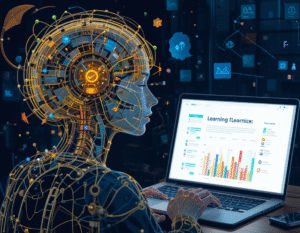Artificial Intelligence (AI) is reshaping the landscape of education, and teachers stand at the forefront of this transformation. While many educators are excited about the potential of AI, others feel overwhelmed or unsure where to begin. The good news? You don’t need to be a tech expert to bring AI into your classroom. You just need a clear understanding of how it can enhance—not replace—your teaching methods.
In this blog, we’ll explore practical, teacher-friendly ways to integrate AI into lessons, including real tools, classroom applications, and strategies to ensure students benefit from intelligent learning support.
Why Should Teachers Use AI?
Before diving into how to use AI, it’s important to understand why it matters in the first place.
AI can help teachers:
- Personalize instruction for different student needs.
- Save time on routine tasks like grading or feedback.
- Access real-time data on student performance.
- Improve student engagement with adaptive content.
- Prepare students for an AI-driven world.
AI isn’t about replacing teachers—it’s about enhancing their role and enabling them to do more of what they do best: inspire, mentor, and lead.
1. Use AI to Personalize Learning
No two students are the same. Some learn best visually, others through hands-on practice or storytelling. AI tools help identify each student’s learning style and adapt accordingly.

How to do it:
- Use platforms like Khan Academy’s Khanmigo or Century Tech, which offer personalized learning paths.
- Let students work at their own pace while the AI adjusts difficulty or suggests different formats (text, video, quiz).
- Analyze AI-generated performance reports to understand where each student needs help.
Tip: Start small—choose one subject or topic and test a tool that adapts to student learning styles.
2. Automate Administrative Work
One of the biggest advantages of AI in education is the ability to reduce administrative tasks.
AI can help with:
- Grading multiple-choice and short-answer quizzes (e.g., Gradescope).
- Taking attendance automatically via facial recognition or smart check-ins.
- Generating progress reports and feedback with tools like Socrative or Quizizz.
Why it matters: Less time grading and tracking = more time teaching and connecting with students.
3. Create Interactive Content with AI
Engagement is key in any classroom. AI tools allow teachers to generate interactive, personalized, and multimedia-rich content in minutes.
Examples:
- Use Canva Magic Write to generate classroom posters, infographics, or learning guides.
- Try Tome AI to create AI-generated slide decks that make lessons more dynamic.
- Use Curipod to build AI-driven interactive lessons, polls, and discussions.
Pro Tip: Assign students to co-create AI-powered presentations as part of a collaborative activity. It enhances their digital literacy and content comprehension.
4. Enhance Writing and Feedback
Writing is essential across subjects, but giving detailed feedback to every student can be time-consuming.
AI writing support tools like Grammarly, Quillbot, or ProWritingAid can:
- Help students correct grammar and improve clarity.
- Offer vocabulary enhancement tips.
- Provide suggestions for better sentence structure.
Teachers can also use AI feedback generators to give personalized guidance faster.
Use Case: Have students write essays in Google Docs, and integrate Grammarly or Scribens for real-time writing help.
5. Use AI Chatbots as Class Assistants
Imagine having an assistant that can answer student questions 24/7, provide reading summaries, or quiz them on key concepts. AI chatbots can do all that—and more.
Tools:
- ChatGPT: Ideal for topic explanations, research help, and Q&A.
- Khanmigo: A GPT-powered tutor aligned with educational standards.
- Jasper (for older students): Helps with writing assignments, projects, and brainstorming.
How to integrate:
- Encourage students to use chatbots for independent study.
- Set rules for ethical use (no using AI to complete assignments).
- Use AI to roleplay historical figures or simulate interviews for creative writing or social studies.
6. Improve Classroom Accessibility
AI tools are revolutionizing education for students with learning differences.
AI-based accessibility tools:
- Microsoft Immersive Reader: Reads text aloud, translates, and changes layout for readability.
- Otter.ai: Transcribes spoken words into text for hearing-impaired students.
- Speechify: Turns text into spoken words for visually impaired or dyslexic students.
How to use them:
- Provide lessons in multiple formats: written, visual, and audio.
- Offer students the choice of how they consume and demonstrate understanding.
7. Gamify Learning Using AI
Gamification boosts motivation and participation. AI-enhanced platforms make gamification smarter and more tailored.
Best tools for AI + gamification:
- Kahoot! with AI-powered quiz generation.
- Quizizz with smart feedback and performance tracking.
- Duolingo (for language learning): Uses AI to tailor lesson paths and offer rewards.
Practical idea: Divide students into teams and let them compete in an AI-generated quiz battle that tests knowledge while making learning fun.
8. Monitor and Predict Student Progress
AI doesn’t just react—it can predict learning outcomes.
Platforms like:
- Socrative
- Edmentum
- Smart Sparrow
…collect data on student performance and suggest timely interventions.
As a teacher, you can:
- Receive alerts when students are at risk of falling behind.
- Adjust instruction based on class trends.
- Use dashboards to visualize student growth over time.
This allows for a proactive teaching approach instead of reacting after grades drop.
9. Use AI to Foster Critical Thinking
One concern about AI is students relying on it too much. However, with the right guidance, teachers can use AI to boost—not replace—critical thinking.

How to do it:
- Assign research tasks where students must compare human-written vs AI-generated content.
- Use AI to pose “what if” scenarios in debates or ethics discussions.
- Ask students to analyze chatbot responses for bias or misinformation.
Example activity:
Ask ChatGPT a controversial historical question. Then have students research and critique its answer.
10. Empower Students with AI Literacy
The future workforce will require AI understanding, regardless of the industry. Teachers can play a key role in AI literacy.
Teach students to:
- Use AI tools ethically and responsibly.
- Understand basic AI concepts like machine learning, data bias, and algorithms.
- Create with AI, not just consume (e.g., writing, designing, coding).
Practical ideas:
- Include short lessons on AI ethics and media literacy.
- Invite an AI expert for a virtual Q&A session.
- Let students create their own mini-AI project using no-code platforms like Teachable Machine.
Steps to Start Integrating AI in Your Classroom
- Start with one tool: Choose a platform that solves your biggest current need.
- Pilot a lesson: Try an AI-enhanced activity in a low-risk subject or module.
- Gather student feedback: Ask what worked and what didn’t.
- Track learning outcomes: Are students more engaged or showing improvement?
- Expand thoughtfully: Slowly incorporate more tools as you and your class grow comfortable.
Challenges and Considerations
AI can be incredibly helpful, but it’s not without challenges:
- Data Privacy: Make sure the tools you use comply with student data protection laws like FERPA or GDPR.
- Digital Access: Not all students have devices or internet access at home.
- Bias and Fairness: AI tools are only as good as the data they are trained on.
- Training Needs: Teachers need time and support to learn these tools.
Solutions:
- Use school-approved tools.
- Provide optional offline activities.
- Teach AI ethics alongside usage.
- Advocate for professional development support.
Final Thoughts: Teaching Smarter with AI
The classroom of the future isn’t just about machines and algorithms—it’s about people using technology thoughtfully. AI gives teachers superpowers: the ability to personalize learning, automate tasks, and make data-driven decisions.
By integrating AI into your lessons, you’re not only improving your own workflow—you’re preparing your students to succeed in a world where AI is part of daily life.
You don’t need to do it all at once. Start small, experiment, and grow. The goal isn’t perfection—it’s progress.
Call to Action:
Have you tried any AI tools in your teaching? What’s worked best for you? Share your experience in the comments and stay tuned for our next post: “AI and Homework: Redefining How Students Learn After School”.
